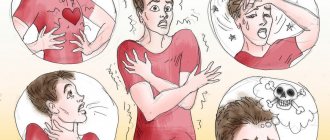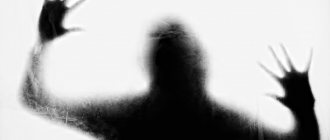Social phobia - how to get rid of it yourself, when is it possible and how? In what cases can you not do without the professional help of a psychotherapist? What are the main psychotherapeutic methods effective in treating social phobia? We asked Chief Medical Officer Vladislav Sipovich, a practicing psychiatrist, psychiatrist-narcologist and psychotherapist, to answer these questions.
What are phobias
The concept of "phobia" comes from the Greek "phybos". This is a mental disorder associated with uncontrollable fear of certain situations or objects. Most often, the factors causing the disorder include insects, people, animals, darkness, etc.
Finding oneself in the same space as an object of fear causes increased anxiety or a panic attack in a person. In this case, the pathology is accompanied by a variety of painful symptoms. In severe cases, the patient is overcome by such strong fear that he can harm himself or others.
What is obsessional neurosis, and does it need to be treated?
The main goal of treatment is to maximize the patient’s quality of life. If a disease interferes with life, then it definitely needs to be treated. Does obsessional neurosis interfere with normal life? To understand this, you need to find out what is commonly understood by this term.
Obsession is the appearance in a person of thoughts or actions that are perceived by him as something alien. A person cannot get rid of them: obsessions force him to perform certain actions, thereby becoming the cause of debilitating mental discomfort.
Types of phobias
The disease is of two types - primary or secondary. The first category includes fears associated with one object or a specific situation. Secondary pathology is characterized by the addition of other disorders. For example, if a person is only afraid of spiders, this is a primary species. If, over time, a second, third and subsequent phobias appear, we can already talk about a secondary pathology.
In total, there are about 40 thousand phobias in the world, so it is impossible to consider everything within the scope of this article. The table shows the main types of violations that occur most often.
| Name of pathology | What Causes Fear |
| Acrophobia | Height |
| Claustrophobia | Closed space |
| Ophiphobia | Snakes |
| Aviation phobia | Flying on an airplane |
| Hematophobia | Blood |
| Agoraphobia | Large open space |
| Keraunophobia | Lightning |
| Entomophobia | Insects |
| Social phobia | Society (people around) |
| Pyrophobia | Fire |
| Eremophobia | Loneliness |
| Arachnophobia | Spiders |
| Gerascophobia | Aging |
| Dentophobia | Dental procedures |
| Kinophobia | Dogs |
| Hypochondria | Diseases |
| Ligrophobia | Darkness |
| Mechanophobia | Motor transport |
| Musophobia | Mice |
| Nosocomephobia | Medical institutions |
Examples of obsessional neurosis
It is very easy to explain the essence of this phenomenon with examples. Let's say you believe that you shouldn't look in the mirror before leaving the house. However, if you accidentally look in the mirror, you will still leave the house without giving it much importance.
Or, for example, a black cat on the road will not force you to reschedule your business: you may be a little worried, but you will soon forget about it. A person with compulsive obsessions, looking in the mirror, will bolt the door and stay at home all day, and, having met a black cat, go to the pharmacy for sedatives.
As you can see, obsessional neurosis makes the patient’s life very difficult. This means that we can say confidently and definitely: this disease definitely needs treatment, and the treatment must be professional and complete.
Symptoms of phobias and their diagnosis
Symptoms directly depend on the type of disease. If a person is afraid of snakes, then when he gets into the same space with the “aggressor factor,” panic may begin. The same goes for other types of phobias. There are also common symptoms that unite all types of pathology. These include:
- Difficulty swallowing and a feeling of a “lump” in the throat.
- Dry mouth.
- Frequent urge to urinate.
- Diarrhea.
- Cardiopalmus.
- Breathing problems, shortness of breath
- Pain in the chest area.
- Dizziness, nausea.
- Noise in ears.
- Deterioration of vision.
- Trembling in limbs.
- Impaired concentration.
- Memory impairment.
- Increased sensitivity to noise.
- Excessive worry.
- Cramps.
- Pre-fainting state.
- A sharp increase in blood pressure.
Often the disease is accompanied by depression, depression and an obsession that something will happen soon.
The concept of phobia - how to distinguish a phobia from other anxiety disorders
A phobia is essentially a hypertrophied, excessive fear. The signs of a phobia are quite distinguishable. To understand the difference between a phobia and ordinary fear, it is important to evaluate the phobic stimulus (what exactly the person is afraid of). If it is ordinary fear, the person usually does not spend much time thinking about its cause, fear arises mainly during an actual encounter with a frightening object (for example, when a person is actually lifted to a height), can be controlled and does not interfere with the implementation of plans to a significant extent. In the case of a phobia, fear will occupy a person’s thoughts for a longer time, signs of a phobia will appear in the absence of a phobic stimulus (cause) and, of course, will affect the person’s quality of life.
What can you do yourself?
You cannot take medications uncontrollably, but you can try to cope with fears through self-affirmation. The methods in this case will be as follows:
- Eliminate stressful situations as much as possible. In this case, going out into nature with loved ones will help. If your fears are related to work or others, it won’t hurt to take a vacation to give your nervous system a rest.
- Don't try to fight obsessive thoughts. The longer a person tries to fight fears, the worse it gets, as panic attacks begin to appear more and more often. It’s better to take it for granted and accept that it’s just a character trait and not a disease.
- Write down and analyze intrusive thoughts. This will help you understand that not everything is as scary as it seems. After all, many people encounter the factors of your fears every day, but nothing bad happens. Simply put, try to convince yourself that “they live with it, so I can do it too!”
- Take soothing baths more often. This will help you relax, get distracted and calm down. If there are no contraindications, you can add tincture of valerian or motherwort to the bath, as well as aromatic oils - lavender, pine needles, cedar, ylang-ylang, citrus, mint, bergamot.
- Conduct morning auto-trainings. To do this, you need to go to the mirror or simply repeat a few phrases over a cup of mint tea - “I’m not afraid,” “I will succeed,” “I’m a strong person,” “I feel happy.”
In addition, playing sports, yoga, relaxing music and even watching funny children's cartoons help.
Are you tired of fighting a phobia? Come to us and we will definitely help
Feeling listened to is almost the best thing in the world. Gregory David Roberts
Considering that recently more and more people have been complaining of anxiety, obsessive fears, anxious suspiciousness, phobias, etc., I decided to once again return to the problem of obsessive-compulsive neurosis in modern man. It is known that obsessive-compulsive neurosis is the result of acquired mental disorders due to poor passage of the stages of psychosexual development, that is, experiences of certain psychotraumas in the prenatal state, during childbirth and in infancy. Of course, traumas from childhood and adolescence have an impact. For example, if the mother and father, due to busyness and immaturity, do not give the child the basal feeling “I am and am good enough” and basal trust in the world, then the child is psycho-emotionally weak, resists socialization and is anxious. Analysis of cases of fear and phobias confirms this fact and shows that the child’s perception of the world around him and himself (negative or positive transfer) depends directly on what the mother transmitted at the energy-psychic level during conception, pregnancy and the infant period of development. For example, if a mother is anxious and projects her neurotic problems onto the child, then the child copies her and further uses her model of responding to stress. In other words, he becomes as neurotic as she is.
Basal trust . Early development of deep trust in one's environment. One of the main concepts in Erik Erikson's theory of psychosocial development: the first crisis in life occurs during the first year and a half, at which time the presence of a loving, reliable and responsible person who cares for the child leads to the formation of a sense of security and basic trust in the environment world, while an unreliable, uncaring and irresponsible person contributes to the development of anxiety, suspicion and basic mistrust.
A woman or man who suffers from obsessions due to their mental immaturity try to stop time on an unconscious level and are afraid to go beyond the boundaries of the “comfort zone” because of a deeper fear of change and expansion of their living space. Resistance to change is also projected in cases where the patient is offered psychological help. It manifests itself in the form of tardiness, passive behavior during psychoanalysis, denial of the dynamics of therapy, etc. Outside of psychotherapy, it can be expressed, for example, in fear for the apartment: “I’m afraid that when I’m not there, the apartment might catch fire.” Of course, in this phrase one can see the problem of fear of society and at the same time a neurotic desire to maintain one’s comfort zone in the same familiar state. Observing the behavior of such a person (if he is next to you), you must understand that such types resist with all their might at an unconscious level the movement towards development and self-realization. This manifests itself in behavior, psychosomatic state, clothing, etc. Their behavior can be interpreted something like this: “I am afraid of growing up, so I hold on to what I have and to which I am accustomed with an iron grip. New experiences and changes are dangerous and impossible for me.” In order to better protect his “comfortable space,” a neurotic comes up with various defenses, which, as I have already noted, have one task - to protect himself from reminders that everything passes, changes and develops. But the more a person is in this conflict of the soul, the more he is haunted by negative thoughts and images about unpleasant, life-threatening situations. Their flow, as practice shows, can easily lead to depression, phobias, etc. I would like to emphasize that when talking about obsessive fears, we must understand that this mental disorder always represents a mixed state of various forms of neurosis, which lead a person further and further from a healthy state.
Above, I noted that obsessive-compulsive neurosis has its beginning in the early stages of development, both in the prenatal state, infancy, and the rest of life in general. When we observe a child suffering from obsessive neurosis, we can see the manifestation of his mental disorder in obsessive movements. These are coughing, tics, facial expressions, etc. These signals indicate that there is a conflict within him, neurotic tension, which is thus released on an unconscious level. They help cope with the fears that the child experiences within the “I”. For example, an obsessive fear of physical abuse from a parent may manifest itself as an eye tic. At the same time, you should know that obsessive fears do not go away with age if the child does not receive psychological help. They are transformed... For example, the same obsessive fear of punishment can further manifest itself in adolescence in the form of fear of getting sick or expressing oneself, defining one’s boundaries in a team, “I-Thou” relationships, etc. It happens that a teenager or young man has immoral thoughts, obsessive desires, as a product of obsessive fear, which in turn only aggravates the neurotic state. All this explains the dynamics in the unconscious of a neurotic: he perceives himself and the issue related to the safety of his living space in a distorted way. One young man during the session said the following about this: “I just can’t build relationships with girls. I have obsessive thoughts that they are dangerous, they cannot be trusted... When meeting a girl, I become cautious, try to anticipate what they are plotting against me. As a result, I am afraid to take the risk of moving forward in the relationship. Further changes and the future scare me... Fog and apathy cover me, and I break up with my girlfriend...”
Obsessive fear forces a person to build high fences, install video surveillance, fill closets with clothes, etc. All this also suggests that the basis of obsessive fear is the fear of death and the obsessive desire to protect ourselves from it. For this reason, a neurotic has such difficulty accepting those situations and those people who feel like they are invading his living space. By accumulating medicines and things, a neurotic person seems to protect himself from a future in which he always sees himself not in joyful, gracious tones. Thus, he protects himself from his own fear, or rather, creates for a while the illusion “Everything will be fine with me.” But this only works for a while, about the same as a glass of vodka for an alcoholic.
The lack of ability to realize that life is changeable and is not subject to conscious control, much less neurotic calculation, makes the neurotic unhappy. He constantly resists his nature and tries to remake, as I said above, everything in his own way. Since the law of the mirror works in the universe, as a result of this behavior the neurotic himself feels that they want to crush him and remake him. For example, in a relationship with a loved one, a neurotic with obsessive fear transfers onto another what he himself would like to do to another. A person who has undergone psychoanalysis understands this behavior, therefore he listens to the other more often, knowing that he, first of all, is talking about himself. For example, a person’s fear of losing control can be indicated by his frequent denial of received information. In my practice, this can be observed in the form of expressions of distrust in the content of dreams and doubts that psychotherapy can help. For psychoanalysis, this is material, the elaboration of which will help the client recover.
It is also necessary to know that a neurotic person suffering from obsessive fear often strives by any means to achieve power (in the family, team, etc.), to gain knowledge and skills in order to protect themselves from an unwanted, unpleasant situation. But this, as a rule, does not help. Practice shows that within his “I” indecision, doubt, and anxiety only intensify. One of my clients said about this: “I have an obsessive fear that I am not attractive and smart enough... I graduated from three institutes, all with honors. And what do you think - what is the result? I doubt myself even more, and anxiety arises every time I lose control. Especially when I had to go to you. It was very difficult, since I didn’t know you, it was not clear to me how we would work with you, etc. Horror gripped me... At the same time, I vaguely understood that this was my problem, the problem of people who, out of fear, want something in life, but cannot get it because they cannot decide.”
Similar cases from my practice show how difficult it is for a person in such a state to take a step towards himself, towards life. And this is only because, as I wrote above, his weak, traumatized “I” experiences a terrible fear of personal responsibility. Individuals prone to obsessions are so anxious and prudent that they are very pedantic in life and get stuck in their sticky conclusions. Their behavior is well illustrated by the following well-known joke: “One man, having got to heaven, saw two doors with signs: “Door to the kingdom of heaven” and “Door to a lecture on the kingdom of heaven.” He thought and entered the second one.” Look around and you will see such people. These types are afraid of big money, of marriage, of having a child, of a possible career. The extreme manifestation of fear of personal responsibility is a phobia.
A few words about phobias
In addition to the obsessive fear of “have I turned off the gas”, “have I closed the apartment”, “will I lose my job”, etc., there are other, more complex, strong forms of obsessive fears called “phobias”.
Social phobia , which includes peirophobia (obsessive fear - fear of public speaking), agoraphobia (fear of open spaces), anthropophobia (fear of people, especially strangers), philophobia - (fear of falling in love), etc. Claustrophobia (from Latin claustrum - closed + phobos - fear) - obsessive fear - fear of enclosed spaces, fear of enclosed spaces, confined spaces, elevators... Xenophobia (from Greek kseno - stranger + phobos - fear) - intolerance towards someone or something foreign, unfamiliar, unusual. Thanatophobia (from the Greek thanatos - death + phobos - fear) - obsessive fear - fear of sudden sudden death.
It is known that when a phobia occurs, it is not so much mental trauma that is important, but rather the fixation (negative anchor) on the primary fear (what frightened). For example, an obsessive fear of death suggests that a person has a problem with the ability to love and be open emotionally. He unconsciously feels that the emotional sphere is closed, and in this regard he is a corpse. Such examples of interpretation make us understand that phobia is a multidimensional mental disorder in which the patient experiences panic attacks, depression and anxiety. The most common signs of a panic attack are: palpitations, suffocation, a feeling that you are about to faint, cold sweat, etc.
So, we understand that what we accumulate and suppress at the mental level then comes out in the form of fears, phobias and other obsessive states. They signal through the body, dreams and emotional level about an internal conflict that asks to be recognized and resolved. And here, as always, the question arises of how to do this. And, of course, I will answer: become aware of yourself. Realize what creates tension and fear within us. Z. Freud, describing the mechanism of work of repressed life impulses, outlined the following: “In erroneous actions - slips of the tongue, forgetfulness, mistakes - everything that was suppressed breaks through, and in the form of mistakes, the feeling of guilt and conscious forbidden desires are passed over, distorted publicity is given to what what must be covered.” If a person overcomes his fear and comes to a psychoanalyst in order to overcome his defense against internal “demons” in the form of obsessive processes, then he has a chance to become a saint. In other words, capable of bringing light to your inner and outer world. Turning his face to his evil, dirty thoughts, to numbing fear, a person, like the hero of a fairy tale, a myth, defeats them and further understands that he is the master of his life, and not those negative programs that were formed at the beginning of his existence. He begins to understand more and more that everything in life has meaning, and he never needs to run away from it. A Latin proverb says: “No matter how violently you drive nature away, it always returns.” This happens on an unconscious level, so always strive to know what the inner “I” and the general information field give you in this regard.
How to help yourself?
In addition to working with your therapist, learn to breathe properly and control your body. By engaging in self-analysis, you will gradually realize the meaning of your fear, and use special techniques to work with the body’s reactions to fear. More often, as I noted above, this is a failure of breathing, various sensations in the muscles (heaviness, numbness, etc.). Below are a few techniques that have helped and continue to help my students.
Breathing exercise “I calm down”
In the process of working on your psycho-emotional state, you need to monitor your breathing. This is very important, since concentration and breathing training, as well as body-oriented techniques, are an integral part of the self-correction process.
Breathing is closely related to the internal psycho-emotional state. Confirmation of this is a violation of the breathing rhythm, deterioration of well-being with obsessive-compulsive neurosis. So, first, feel how you breathe, how you inhale and exhale...
You can practice breathing deeply and slowly anywhere. But for the first training, it is convenient for you to choose a place where it is calm, clean air and no one will disturb you for 5-10 minutes.
Progress of the exercise
Sit in a chair... Close your eyes... Turn on calm music (the exercise can be done in silence)... Breathe through your nose... Concentrate on your breathing... Feel how the inhalation and exhalation flows... Through which nostril (right - Yang energy (male), left Yin energy (female)) air passes better... (awareness of this moment will help you find out where the cause of fear is: in the male or female space of your “I”)... Be aware of what thoughts, emotions, images come to you at the moment... Record their presence and switch all your attention on your breathing...
Slow down your breathing, take a deeper breath and exhale (to a comfortable state). Feel how the air enters, fills your chest, stomach to the navel and exhales... Imagine that you are inhaling calmness and exhaling anxiety!
Source
Phobia Treatment Clinic “Solution”
Treatment should be carried out by experienced specialists with extensive experience. With improper therapy, the patient's condition rapidly deteriorates. Doctors at the Reshenie clinic have been treating complex diseases, including phobias, for 18 years. Methods are selected individually after making an accurate diagnosis. Effective proprietary methods and a competent approach to the problem allow you to quickly eliminate pathologies and save patients from painful attacks. If you need treatment for depression and phobias, trust your health only to certified doctors.
Signs of a phobia
A person suffering from a phobia can quite normally lead a normal life, without standing out from others. The disease may in no way affect mental activity, family life and career growth. All problems in this case begin at the moment of contact with a phobic stimulus, the cause of the phobia. In this case, a person instantly loses control over himself, and fear does not respond to any influence of rational thinking and logic. The main signs of phobias:
- - chills;
- - sweating of the extremities;
- - tachycardia (rapid heartbeat);
- - suffocation;
- - darkening of the eyes;
- - state of horror.
Contact a specialist
Sign up for a consultation tel. 242-82-65
Make an appointment
Yuri Lvovich Muchnik
Psychiatrist-narcologist
Doctor of the highest category. 35 years of experience. Works at the Clinic named after. prof. F.F. Preobrazhensky since 2001
How we work with patients
Treatment at the Reshenie clinic is based on eliminating symptoms and the disorder itself. Main stages of therapy:
- Introductory sessions with the patient, where doctors provide complete information about the disease and answer all questions.
- If, in addition to phobias, the patient has symptoms similar to other pathologies, a consultation with highly specialized specialists is prescribed.
- Work to correct the patient's behavior. At this stage, doctors tell you how to cope with fear and control emotions.
- Other techniques, depending on the person’s condition, are hypnosis, physiotherapy, psychotherapy.
It is worth noting that the result depends both on the correctness of the selected technique and on the patient himself. If a person does not interact with specialists, treatment may be delayed. To quickly get rid of the disease, it is important to follow all the doctor’s recommendations and not miss sessions.
Manifestations of obsessional neurosis
The most common manifestation of obsessional neurosis is fear, which is very difficult and sometimes almost impossible to overcome. Phobias make social contacts, work and all other aspects of life very difficult.
Another version of neurosis is, in fact, obsessive thoughts that a person cannot “drive” out of his head. These thoughts interfere with learning, concentration and greatly tire the patient. An important criterion: a person with obsessional neurosis never realizes his thoughts. The last type is compulsive. It manifests itself through obsessive movements and excessive ritualism.
Treatment methods for phobias
Several methods are used to eliminate pathology - psychotherapy, drug treatment, hypnosis, treatment using virtual reality, physiotherapy, and the NLP method (neurolinguistic programming). The latter implies a special technique “symptom, cause, result, resources and effect.” The second name of the method is rapid treatment of phobias. We use modern techniques and work for results, so we try to use medications only in the most extreme cases.
Causes of phobias
The exact etiology is not fully known. Many experts believe that such a mental disorder in an adult is a consequence of various severe childhood fears. Usually by adolescence they go away on their own, without the intervention of a psychotherapist, but in some cases they persist, sometimes taking on a bizarre form. It is assumed that the cause of anxiety at an early age does not disappear as one grows up, but is “replaced” by another object. Certain forms of pathology arise already in adulthood as a consequence of strong stress factors (for example, fear of horses after a fall and injury, etc.). A phobic disorder of the social type (fear of public attention, criticism) develops with a special mindset and character. The disease manifests itself in adolescence (at the end of puberty), when boys and girls actively make new friends and attach great importance to how others perceive them. Doctors do not exclude that the cause of the disease is also damage to the central nervous system - certain areas in the brain that “control” the development and maintenance of anxiety.
FAQ
What is the difference between fear and phobia?
Fear is a normal protective reaction of the body to a dangerous situation. After the fear factor is eliminated, the condition returns to normal, and the symptoms no longer return. If an uncontrollable feeling of fear occurs regularly without any known reason, this means that the person has a phobia.
Is phobia an incurable pathology?
The disease responds well to therapeutic measures; the main thing is to approach this issue correctly and competently. Treatment methods are selected depending on the severity of the pathology, symptoms and the cause that caused it. The effectiveness of therapy in this case directly depends on the patient’s desire to get rid of the phobia.
Is it possible to cure the disease on your own?
It is better to consult a doctor, as improper treatment will only make the disease worse. An experienced psychotherapist works using modern methods and knows which one is best to apply in a given situation.
Is it possible to die from a phobia?
Despite the fact that there is an expression “I almost died of fear,” cases of death are practically excluded. There are situations when, in a state of panic, a person loses self-control and can harm himself. This phenomenon is very dangerous and leads to serious consequences, including death. This is why you should not self-medicate. It is better to contact a psychotherapist as soon as possible.
Is it possible to get rid of a phobia that has been haunting you for several years?
It doesn’t matter how many years a person suffers from a phobia - the disease can be treated at any time. For this, there are special techniques that relieve the patient from panic attacks once and for all.
Healing by provocation
Our fears can be treated, sometimes unexpectedly quickly.
What about phobias? This uncontrollable emotional overreaction only occurs in certain situations, just as an allergy becomes an immune overreaction in response to exposure to a specific allergen. To free yourself from such dependence, you need to artificially induce a sudden fear reflex: consciously put yourself in frightening situations, getting used to them and gradually increasing the impact of provoking factors.
This technique is similar to the treatment of allergies: there is a gradual adaptation to the allergen and at the same time a decrease in sensitivity to it. For example, in order to stop being afraid of pigeons, you must first get used to the image of these birds in the photo, then accustom yourself to look at a pigeon in a cage, and then approach a flock of pigeons in a park...
The goal of psychotherapy is not liberation from phobia, but the introduction of fear into a natural framework: it must become adequate and controllable. Often those who suffer from some kind of phobia begin to “fear the fear itself.” And “getting used to fear” exercises combined with relaxation techniques help you learn to accept it as inevitable. By ceasing to be afraid of your fear, you can begin to treat it more calmly - understand, react, overcome.
Reviews about the treatment of phobias
Maria, 32 years old. Astrakhan. “Since childhood, I was very afraid of heights and could not even go near the windows in the apartment. Although we live on the second floor. For a long time I tried to cope with the disease on my own, but nothing worked. After another unsuccessful attempt to pull myself together, I decided to go to the clinic. I can say that I have no regrets at all. In fact, everything turned out to be simpler than I thought. Several sessions of psychotherapy and hypnosis helped eliminate the disease and look at life in a new way.”
Mikhail, 42 years old. Moscow city. “I tried a bunch of ways to treat claustrophobia at home. All this is not the same. Apart from a doctor, nothing will help. I visited our local clinic. 15 sessions were enough to get rid of the disease forever. So it is better not to self-medicate and not to put off going to a specialist for too long. Only a psychotherapist can quickly relieve depression and phobias.”
Arina, 27 years old. Bryansk. “For 5 years I suffered from terrible panic attacks. To be honest, I even had thoughts of suicide. I once found a message from a girl on a forum, where she described the same situation as mine and recommended that I see a psychotherapist. The treatment wasn’t as quick as it turned out, but I’m happy with the result.”
How to overcome social phobia on your own?
If a person suffers from monophobia, then there is a high probability that he will be able to cope with it on his own. But consulting a psychologist or psychotherapist obviously wouldn’t hurt. A specialist will be able to give recommendations taking into account your type of nervous system, the main channel of information perception, specific life circumstances and the severity of symptoms. Of course, I can give some practical advice on how to get rid of social phobia on your own, but I still insist on the need for preliminary consultation. So, first of all, a person with manifestations of social phobia must change his way of thinking: • Completely get rid of negativity towards himself. • Firmly understand that he has something to say and offer to others. • Realize the pointlessness and futility of avoiding the company of other people, and also that they are not monsters and they have something to do other than discuss your qualities and actions. • Convince yourself of your purposefulness and the significance of your own thoughts and actions. You can achieve these results and learn to think positively if you think about it for 10-30 minutes every day.
In addition, if you do not want to seek advice from a psychotherapist, you can find on the Internet people with similar problems who have successfully coped with social phobia. Find out how they managed to do this, and try to find for yourself the most positive and acceptable solution on how to overcome social anxiety in yourself. Positive thoughts are followed by the next stage - getting rid of fear. After all, no matter how positively you set yourself up, anxiety and fear, a feeling of discomfort and awkwardness when communicating with other people still remain. This is what you should do: • At the first sign of panic, start breathing deeply, do not make sudden movements and do not convince yourself that you are not afraid. Violently denying fear can only make it worse. Just try to fix your attention on something else, for example, the rhythm of your breathing. Do not avoid situations that frighten you, even carefully meet them halfway and each time accept the challenge of your own phobias. Believe me, only those who fight win. • You should not start with sudden attempts to immediately plunge fully into your fear; start small and gradually. For example, if you are afraid of crowds, then you should not immediately mix with a large number of people - just stand at a distance and watch what is happening. Then you can start asking questions to strangers, for example, what time is it, how to get somewhere, etc. Subsequently, you can try to talk to a person of the opposite sex. • Establishing business connections and contacts will be the next step in the fight against fear. Make purchases yourself, ask other buyers for their opinions about the product, contact sellers and managers for advice, and in transport, feel free to warn about your stop, and do not wait for someone to demand it before you. Be moderately active in such situations and over time the fear will become less and less. • Try not to depend only on the opinions of others, increase your self-esteem, trust your opinion and intuition. Hear your inner voice and then those around you will hear you. To overcome feelings of insecurity and become convincing to yourself and others, do the following exercises: • Developing beautiful speech by reading poetry aloud. • Coming up and presenting speeches for yourself on any topic. • Tell yourself about the past day's activities and the weather. • Training on close communication skills. • You can even try pantomime in front of a mirror, showing with signs what you want. This will make you feel more relaxed and eliminate the fear of looking ridiculous and funny. And yet, you always need to be internally prepared for communication, for the fact that someone wants to ask you about something or find out your opinion on a certain problem. To avoid getting into an awkward position, first understand the essence of the question and then answer. Understand that your opinion is really important to others if they are interested in it. To summarize, I can give a rough plan on how to treat social phobia yourself: • Recognize your problem, do not deny it and do not put off solving it until later. • Change your lifestyle, get active in a good and careful way, stay alone less and try to go out “in public.” • Don't forget about the above training. • Develop a sense of humor, be able to laugh at yourself and your fears. After all, nothing bad happened because they made fun of you or laughed at you. Remember the old Jewish joke: “It’s not scary when they laugh at you, but when they cry at you.” • Do not use doping in the form of alcohol, much less soft drugs, to increase sociability. • Do not accumulate resentment and do not hold grudges. Rancor and hatred are bad advisers in establishing communication with other people and are destructive to the psyche. If all your attempts have not brought significant results, seek professional help from a psychotherapist who will competently assess the depth of your problem and prescribe adequate psychotherapeutic and, if necessary, medication treatment.
Phobia: symptoms, main forms of the disease
The clinical manifestations of the disease primarily depend on its type.
There are several types of phobias:
- Simple. The patient develops an uncontrollable and clearly inadequate fear at the sight of a certain object, animal (insect), or before any situation (flying, going up to a height, changing weather, etc.). Due to a strong feeling of anxiety, a person diligently avoids such “irritants.” Some live in almost constant stress, often limiting themselves (for example, in travel, tourism, entertainment), without turning to a specialist.
- Social phobias. A person is afraid of situations when other people are watching him because of fear of discussions behind his back, criticism, ridicule. He tries to avoid public places (restaurants, cinemas, entertainment venues), avoids various meetings, conferences, lectures. This has an extremely negative impact on the patient’s quality of life, since fear often pushes them to use alcohol and drugs.
- Agoraphobia. A patient suffering from this form of disorder experiences extreme anxiety when he finds himself outside the home, among crowds, in places that he cannot quickly and independently leave. Agoraphobia is much more often accompanied by anxiety and depressive disorders, and depersonalization.
- Hypochondriacal phobias are fear of an existing concomitant pathology or fear of possible diseases. As a rule, they are afraid of oncology, infections (tuberculosis, tick-borne encephalitis, viral diseases, etc.). The patient constantly undergoes tests, undergoes examinations, turns to various specialists, but even a negative result relieves him of fear only for a short time. The patient listens to himself so much that the possibility of psychosomatic hypertension and autonomic dysfunction cannot be ruled out. And a banal slight deterioration in well-being, which many simply do not notice, can cause a panic attack.
Typical signs
The most common manifestation of a severe illness is a panic attack, for which the following symptoms are typical:
- heartbeat;
- tightness, feeling of heaviness in the chest;
- feeling of suffocation and lack of air;
- sweating;
- dizziness;
- a distinct fear of death or impending serious illness (heart attack or stroke, insanity, loss of consciousness, etc.);
- numbness in the body;
- convulsions (not common).
Clinical manifestations increase quickly; in general, an attack usually lasts about 30 minutes, less often - several hours.
According to the mechanism of manifestation, panic attacks are divided into:
- spontaneous, developing unpredictably;
- attributive, arising under the influence of certain circumstances or situations.
Without appropriate treatment, episodes of panic attacks and fear can develop into a chronic disorder. At the same time, in the intervals between attacks, an anxious and restless mood remains - the patient all the time subconsciously expects and experiences fear of certain objects.
Does your relative have a mental disorder?
Refuses hospitalization? Are you afraid that he will harm himself and others? Call or request a free consultation.
URGENT CONSULTATION
The doctor will arrive within 1 hour . We'll take you to the hospital ourselves. Emergency hospitalization - around the clock!










